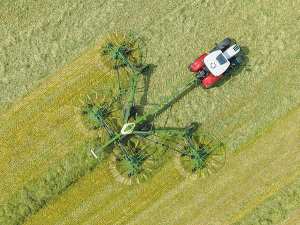Krone EasyCut B1250 fold
In 2024, German manufacturer Krone introduced the F400 Fold, a 4m wide disc front mower, featuring end modules that hinge rearwards to reduce the transport width to less than 3m.
 The Swadro TC1570 four-rotor centredelivery rake is said to be an ideal fit for highways in paddocks.
The Swadro TC1570 four-rotor centredelivery rake is said to be an ideal fit for highways in paddocks.
Controlled Traffic Farming (TCF) systems see arable operators, using tramlines as “highways” for moving through a crop.
Then, use machinery with specific operating widths to ensure there is no need to move off these tracks, thereby limiting compaction to the tramlines, rather than across the whole paddock.
While CTF has never really been used in dairy operations, German manufacturer Krone suggests this is changing as forward-thinking dairy farmers strive to limit compaction, particularly in wetter seasons.
The company suggests that with a maximum working width of 15.70m, the Swadro TC1570 four-rotor centredelivery rake is said to be an ideal fit for such operations.
Wider than the existing four-rotor TC1370, the V-frame concept on the newcomer is said to be an adapted version of the six-rotor TC2000.
Featuring 15 tine arms on each of the rotors, the mechanical driveline sees the front two rotors rotating about 25% faster than the rear units, which the company suggests promotes optimum forage flow through the machine to create tangle-free, box-shaped swaths. Operated via an ISObus terminal or in combination with an ISObus joystick, overall working width is adjusted by the two front rotor arms, while final swath wide of 1.40 to 2.90 metres is hydraulically adjusted via the rear pair of rotors.
The main frame can be lowered hydraulically to reduce the transport height to below 4.0m without the need to fold or remove any tine arms. The transport chassis is equipped with 710/40 R22.5 tyres as standard, or optional 800/35 R22.5 units, while infield stability is improved with the use of wide 16 x 9.50-8 tyres on the fourwheel rotor chassis’ and the 15/55-17 support wheels on the two front arms.
Electric height adjustment allows individual or simultaneous rotor adjustment, will the choice of two preselected heights to be saved on the terminal and activated at the touch of a button.
At headlands, the rotors can be set to lift just over existing swaths, while the lift delay of the rear rotors is also adjustable, and the automatic Soft- Down mechanism slows the speed of lowering just before the rotors touch down. Section control is also available to lift/lower the rotors automatically using GPS.
Acclaimed fruit grower Dean Astill never imagined he would have achieved so much in the years since being named the first Young Horticulturist of the Year, 20 years ago.
The Ashburton-based Carrfields Group continues to show commitment to future growth and in the agricultural sector with its latest investment, the recently acquired 'Spring Farm' adjacent to State Highway 1, Winslow, just south of Ashburton.
New Zealand First leader and Foreign Affairs Minister Winston Peters has blasted Fonterra farmers shareholders for approving the sale of iconic brands to a French company.
A major feature of the Ashburton A&P Show, to be held on October 31 and November 1, will be the annual trans-Tasman Sheep Dog Trial test match, with the best heading dogs from both sides of the Tasman going head-to-head in two teams of four.
Fewer bobby calves are heading to the works this season, as more dairy farmers recognise the value of rearing calves for beef.
The key to a dairy system that generates high profit with a low emissions intensity is using low footprint feed, says Fonterra program manager on-farm excellence, Louise Cook.
OPINION: Microplastics are turning up just about everywhere in the global food supply, including in fish, cups of tea, and…
OPINION: At a time when dairy prices are at record highs, no one was expecting the world's second largest dairy…